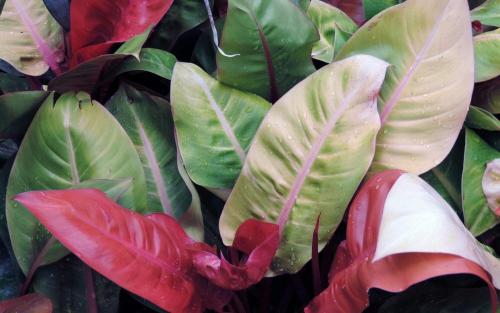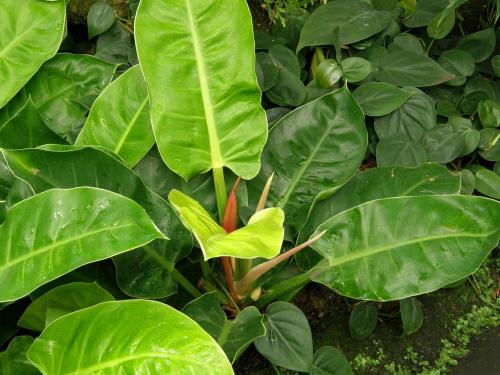Thanks to the author Avery Haislip for giving her gracious permission to reproduce the article in its entirety.
https://longwoodgardens.org/bl...
Winter is for Houseplants
By Avery Haislip, on January 17, 2024

Winter months may seem like a challenging time when it comes to caring for plants—but this time of year is the perfect time to bring color and texture into your home with intriguing and fun houseplants! There is such an array of gorgeous plants to add vibrancy indoors, many of which you can find on display in the Conservatory for inspiration. The winter season is also a fantastic time to repot or up-pot existing houseplants, refresh your plants' appearance or display in your home, or even train plants to grow in new ways. Follow along as I share some fantastic houseplants to add to your home, as well as ways to keep your existing houseplants thriving and beautiful this season.
Interested in bringing a houseplant into your home but not sure how to start? A lovely starter houseplant for any level of expertise is any plant of the Philodendron genus. With a wide variety of foliage textures, colors, and growth habits, they are a fun and quirky tropical addition to your home. Some notable species and varieties that are currently on display in the Conservatory include Philodendron 'Moonlight' and P. 'Prince of Orange'.

Philodendron 'Moonlight' offers a great splash of chartreuse with a pop of orange from the new growth. Photo by Cathy Matos.
All of these philodendron varieties will thrive at 65 to 80 degrees Fahrenheit and can tolerate moderate to low light, but do prefer a higher level of humidity. A great place to display these philodendrons could be in a windowsill close to a sink, or in the bathroom where they will experience a higher humidity environment each time you run the shower. If you happen to have a less than ideal location for display in your home, you can supplement the higher humidity levels by either applying mist (via a fine mist sprayer) to increase moisture on the surface of the leaves, or setting the plant in a shallow tray filled with gravel or stone filled with water to offer a source of relative humidity close to the plant. You can even get creative with the added humidity feature by playing around with pebbles of differing colors or textures to complement the plant or pot, adding to the aesthetic of the houseplant while also offering functionality!

Philodendron 'Prince of Orange' provides gorgeous orange new growth. Photo by Cathy Matos.
Additional maintenance is dependent upon the variety of philodendron. P. 'Moonlight' and 'Prince of Orange' are considered "self-heading" varieties that will grow with a more upright habit and won't require any training or pruning to maintain their size and shape. Representing a similar genus, Epipremnum aureum 'Neon' is a trailing plant, in which a simple pruning back to a leaf or node is all that's needed to maintain a controlled and compact look. Allowing the plant to trail along a windowsill or drape over a table edge can also have a lovely effect.

Epipremnum aureum 'Neon'. Photo by J.W. Moore.
If you are interested in training your philodendron to climb, a fun and easy DIY option is to build a "moss" pole for your plant! All you need is chicken wire or some type of open netted material (such as tree protection covers), potting soil, fasteners (zip ties or twist ties) sphagnum moss, and floral pins/staples. Using the chicken wire or netted material, create a cylinder about 1 to 2 inches in diameter and fasten with zip ties or twist ties. Fill the cylinder with potting mix, and fasten the pre-moistened sphagnum moss (by soaking in a bucket or bowl of water) to cover the pole using the floral pins or staples. Bury the moss pole into the pot you are planning to grow your philodendron in, fill with soil and plant, then weave the stems around the pole and fasten with twine. An additional benefit to the pole is that you can water from the top of the pole to keep the sphagnum moss moist, offering a source of moisture and humidity to encourage your philodendron to continue up your DIY moss pole.
For most of your houseplants that don't have any trailing habits and thus don't require much pruning or training, there are still hands-on opportunities to refresh your plants' appearance and display within your home. Great lower-maintenance and low-light-requiring houseplant options include Aglaonema 'Osaka', Streptocarpus 'Concord Blue', and Peperomia ferreyrae 'Nevada' and P. caperata 'Frost', all which can also be seen on display as beautiful foliage and bedding crops in our Conservatory.

Streptocarpus 'Concord Blue' trailing in a beautiful basket form. Photo by Judy Czeiner.

Peperomia ferreyrae 'Nevada' adds a playful, succulent-like texture. Photo by Amy Simon Berg.

Peperomia caperata 'Frost' offers a great contrasting silver hue. Photo by Amy Simon Berg.
Winter months are a great time to repot, offering a chance to downsize anything that is in too much soil (and staying too wet), which could lead to mushy, brown roots that are signs of root rot. Repotting also offers a chance to up-pot plants that are outgrowing their current pots; signs could be roots coming out of the bottom, or if the plant tends to dry out quickly. If you're looking for more whimsical way to repot your houseplants, consider repurposing broken pots with kintsugi.
Feeling extra creative this winter? The art of kintsugi (meaning "to join with gold') is a 500+-year- old Japanese tradition of mending broken pottery (traditionally with pine resin) and flaking the cracked seams with gold to intentionally highlight the crack, as a means of cherishing and celebrating the imperfections of pottery and more importantly life. This beautiful and symbolic tradition can be implemented at home with just a few materials, and doubles as a thrifty way to repurpose and salvage any broken pots you may have. Kintsugi is as simple as piecing together a broken pot, fixing the adjoining pieces with epoxy, then adorning the mended cracks with gold paint, foil, or any other dazzling color or shade you would enjoy. Repotting your houseplants in your kintsugi will offer a gorgeous second life to your pot and add a small accent to your home décor.
Need more indoor plant inspiration for the winter? Take a stroll through our lush Conservatory, awash in vibrant hues, various textures, and inspiration at every turn.






